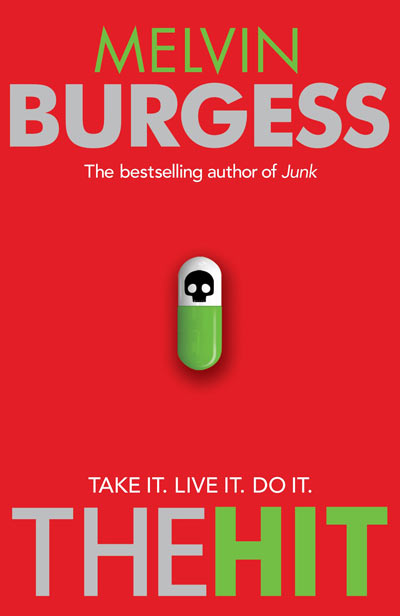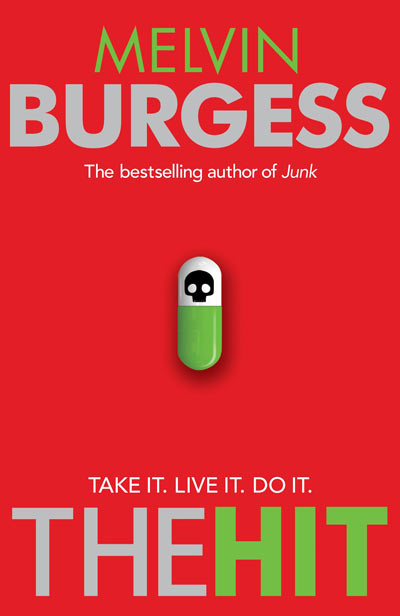W ith The Hit, Melvin Burgess takes on several key social and philosophical issues: political corruption, drug abuse/use, social class and power disparities, and measuring life’s value. When the world begins to spin out of control and all hope seems lost, we look for an escape. For seventeen-year-old Adam, who can only see hard work ahead and never earning enough to do what he wants, that escape is the drug called Death. Death started out as a euthanasia drug, one that would give the terminally ill a week of bliss. But when the young began to look at it as “the biggest high”—a way to improve mentally, physically, and sexually—suicide escalates. With strength, fitness, belief, a bucket list, and minimal consequences to pay, Death seems like an alternative to pain.
ith The Hit, Melvin Burgess takes on several key social and philosophical issues: political corruption, drug abuse/use, social class and power disparities, and measuring life’s value. When the world begins to spin out of control and all hope seems lost, we look for an escape. For seventeen-year-old Adam, who can only see hard work ahead and never earning enough to do what he wants, that escape is the drug called Death. Death started out as a euthanasia drug, one that would give the terminally ill a week of bliss. But when the young began to look at it as “the biggest high”—a way to improve mentally, physically, and sexually—suicide escalates. With strength, fitness, belief, a bucket list, and minimal consequences to pay, Death seems like an alternative to pain.
Until his dad had an accident, Adam used to be one of the rich kids going to a rich school with a rich lunch in his bag, and a rich education at the other end. But unable to afford to send two children to university, Adam’s older brother Jess, who is the better bet educationally, gets his parents’ support.
Early on in the book, with the mention of rat masks, the Zealots as a revolutionary force, and their logo “an angry rat with a pot of paint” (38), I guessed that this was a Banksy inspired story. Banksy is a pseudonymous England-based graffiti artist, political activist, film director, and painter. Known for his contempt for the government, for being controversial, and for his philosophy “freedom and food for all” (16), Banksy inspires admiration and provokes outrage in equal measure. Banksy made his name with his trademark stencil-style ‘guerrilla’ art in public spaces. His satirical street art and subversive epigrams combine irreverent dark humor. Such artistic works of political and social commentary have been featured on streets, walls, and bridges of cities throughout the world.
When Jess is reported dead, the little hope and optimism that Adam knows turns to despair. The brother he thought he looked down on, Adam realizes he in fact admired above all others. Now, the future leers at Adam “like a rotting skull—stinking, filthy, and full of fear” (73). Pumped up on Death, Adam believes himself to be “witty, attractive, full of ideas and jokes. . . . His problems . . . all [disappear] into a sparkling fountain of happiness and well-being” (56). With heightened senses, Adam experiences life like he never has before. He has a sense of power and feels capable of anything. After taking Death, he gets his life back in spades! With Lizzie’s help, he creates a bucket list and begins to complete it. But, early on he realizes that life oscillates between being a total adrenaline rush and utter boredom. With his life ticking away, he also takes stock of what is important to him: trees, chocolate, fresh air, cars, apples, pears, music, jokes, falling in love, “the whole damn adventure” (278) his mum described. Like Jess, Adam also realizes the importance of standing up for what he believes in. He decides to fight against the rich getting richer, the poor getting poorer, and the youth killing themselves for a good time.
Set in Manchester,England, this isn’t just a philosophical tale; this is a culture jammer’s tale about revolution and social change. And it is not without its villains. The key villains are Florence Ballantine, his psychotic son Christian, and a body guard named Vince. All three use their money and their power to bully others—and their brand of bullying is gruesome and violent.
With The Hit, Burgess wakes his readers up, making them think:
- Would I take Death?
- What would be on my bucket list?
- What do I value in life?
- How bad does life/society have to get before I act?
- Do I fight against the forces of evil?
- Is love enough to call life fulfilling?
- Posted by Donna

